Using A Microlife Peak Flow and FEV1 Meter
This information was reviewed and approved by Deborah Fending (10/19/2015).
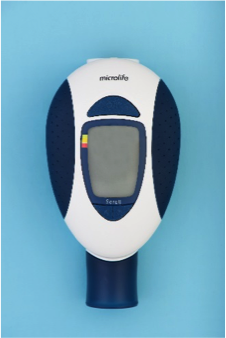 What is a Microlife Peak Flow & FEV1 Meter?
What is a Microlife Peak Flow & FEV1 Meter?
The Microlike peak flow & FEV1 meter is a small, easy-to-use instrument that enables you or your child to measure lung function at home, at work, at school — wherever you go. The peak flow meter measures how fast a person can blow out air after a maximum inhalation. It helps reveal how well you or your child's lungs are working. The Microlife measures PEF. This is the peak expiratory flow rate. In addition, the Microlife also measures FEV1. This is the Forced Expiratory Volume in the first second you exhale. Many peak flow meters measure PEF, but not FEV1. The Microlife peak flow & FEV1 meter measures both.
Why Use a Microlife Peak Flow & FEV1 Meter?
People with asthma may not always feel the early changes taking place in their airways because these changes often occur gradually. In addition to watching for daytime symptoms, nighttime symptoms and activity level a Microlife meter can help you monitor asthma control. A peak flow meter can be especially useful if you or your child have moderate to severe asthma or have trouble identifying asthma symptoms.
A daily (or regular) record of peak flow numbers can provide you with a valuable early warning sign. Sometimes peak flow numbers will decrease hours, or even a day or two before other asthma symptoms become evident. When you monitor peak flow numbers on a daily (or regular) basis, you can identify this drop and take steps to prevent an asthma episode. The peak flow numbers, along with watching for asthma symptoms and activity can be used to make decisions about level of asthma control and treatment.
People with asthma can benefit from an objective means of assessing asthma symptoms. The Microlife meter is an inexpensive, practical way to measure lung function at home.
The Microlife meter measures how fast and how much air you or your child can blow out after taking a deep breath. As reviewed above, these measures are PEF and FEV1.These measures, which are read as numbers, may reflect the amount of obstruction in the airways. Monitoring peak flow and FEV1 numbers can help you and your health care provider assess lung function. This is helpful in making decisions about the following:
- Effectiveness of asthma medications,
- Adding or stopping medication(s),
- When to seek emergency care
- Effectiveness of environmental control measures and
- Level of asthma control.
Peak flow and FEV1 numbers are effort dependent. This means you or your child needs to put forth a good effort to have reliable, consistent results.
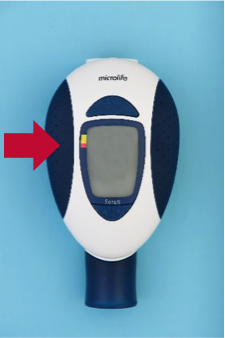 How to Insert or Change the Batteries
How to Insert or Change the Batteries
The Microlife meter does not come with the batteries in the device. You must put the batteries in the device before you use it. The battery cover is on the side of the device.
- The arrow shows where the battery cover is. Open the battery cover from the back.
- Insert the 2 batteries. Place the negative and positive side in the correct position.
- Replace the battery cover.
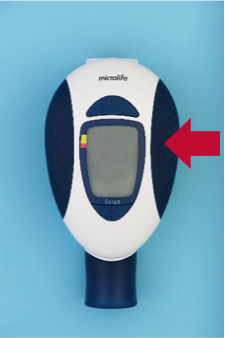
How to Set the Date and Time
- The arrow shows where the data compartment is. Open the data compartment from the back.
- Press the small time switch next to the clock symbol with a pen or paper clip end, 2002 will blink. Release the switch.
- Now you can press the keys on the front of the peak flow meter <> to decrease of increase the year.
- Press the time switch again to confirm the year setting.
- Repeat this process with the month, day, hour and minutes.
- Press the time switch again to confirm all settings. The monitor will switch to ready.
- Close the data compartment
- You are ready to use the peak flow meter.
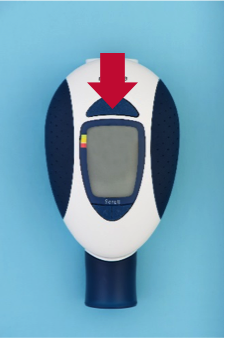
How to Use the Microlife Meter
- The arrow shows where the ON/OFF button is. Press on ON/OFF button to turn the monitor on.
- The display will show the most recent test results. The device is ready when there are two short beeps and >>>show on the monitor.
- Stand up (or sit up straight). Hold the Microlife meter with both hands holding the blue side areas.
- Take a deep breath in.
- Place the mouthpiece in your mouth; close your lips around the mouthpiece. Do not put your tongue in the mouthpiece.
- Blow out as hard and as fast as you can without bending over. Blow for at least 2 full seconds.
- A long beep confirms that the result is recorded. Look at the display. Your test results will appear in the display right away. The test results will change from PEF to FEV1. If your zones have been set, an arrow will point to the zone you are blowing in, green, yellow or red.
- Repeat steps 3 through 8 two more times. The Microlife will select and save the highest of the three good results from the time the device is turned on and off.
- Press the ON/OFF button again to turn the device off.
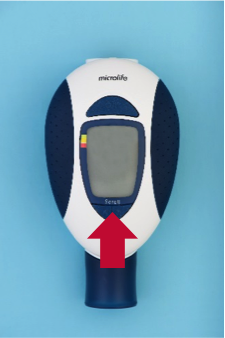 Keeping a Record
Keeping a Record
The Microlife meter holds up to 240 test results in the memory. To view the stored tests, press the memory scroll buttons. By pressing <, you can see the latest value stored in the memory. Pressing this button once at a time shows all stored date. The > button works in the opposite direction.
Keeping a record of the highest PEF and FEV1 blows is helpful. The record may be:
- Using a Microlife software package to download and graph the results onto your computer. There is a card in box with the meter with directions to download the software.
- Graphing the highest of the three results on a graph or diary.
- Recording the highest of the three results on a calendar.
The peak flow information should supplement record keeping of asthma symptoms, use of inhaled medications, activity level and nighttime awakenings due to asthma. This allows you, your child and your health care provider to monitor trends that indicate changes in lung function.
How to Determine Your Personal Best?
The highest number you or your child can blow regularly is the "personal best". This is determined by recording peak flow numbers for two to three weeks when asthma is under good control. Use the highest number you or your child can regularly blow. Asthma is often controlled when you or your child does not experience asthma symptoms (including nighttime symptoms) and maintains a normal level of activity. Talk with the health care provider about your or your child's "personal best".
How to Determine Your Zones?
Once your personal best is determined, it may be helpful for you and your health care provider to establish zones. Zones will cue you about how well your breathing is and actions you should take. The zone system can be compared to the colors of a traffic light, green, yellow and red.
- Green Zone (often 80%-100% of personal best) signals ALL CLEAR.
- Yellow Zone (often 50%-80% of personal best) signals CAUTION.
You or your child may need more aggressive medical management for asthma. This may include a temporary increase in quick-relief medicine and inhaled steroid medicine, an oral steroid burst or other medicines as prescribed by your doctor.
- Red Zone (often 50% or less of personal best) signals a MEDICAL ALERT!
You or your child needs immediate treatment with a quick-relief medicine. Notify your doctor or seek emergency care if peak flow numbers do not immediately return and stay in the yellow or green zones.
You or your child’s health care provider can help determine what the personal best is and what steps to take when the peak flow numbers are in the green, yellow and red zone.
Microlife Meter and the Zones
Many peak flow meters have zone indicators. The Microlife has a green, yellow and red indicator on the meter. The peak flow percentages we suggest are guidelines only. Establish peak flow zones with your health care provider. In children, the personal best number and the zone numbers will change as the child grows; these numbers should be reevaluated every six months to one year.
When Do You Use Your Microlife Peak Flow Meter?
The frequency that you and your child record peak flow numbers depends upon the severity of the asthma, the season, the pattern of symptoms and other factors specific to each person. People with moderate, severe or unstable asthma and people who have trouble identifying asthma symptoms may need to record peak flow measures twice a day.
How Do You Clean and Disinfect the Microlife Meter?
Remember to clean and disinfection your Microlife Meter to keep it recording accurately. To clean and disinfection your meter:
Mouthpiece
- Once a week disconnect the blue mouthpiece from the measuring tube and put it into continuously boiling water for at least 10 minutes.
- Shake of the excess water and dry thoroughly on a towel.
- Once dry, put the blue mouthpiece back on the measuring tube.
Measuring Tube
- Disconnect the white measuring tube from the mail unit by moving it in the forward position.
- Disconnect the blue mouthpiece from the measuring tube.
- Rinse the white measuring tube in distilled water, not tap water. Never put the measuring tube in boiling water
- Shake off the excess water and dry thoroughly on a towel.
- Once dry, put the blue mouthpiece back on the measuring tube. Put the measuring tube back on the main unit. Make sure the measuring unit click onto the main unit.
Main Unit
- Wipe the main unit off daily with a clean damp cloth. Do not put the main unit in water.
Remember, in addition to watching for daytime asthma symptoms, nighttime asthma symptoms and activity level a Microlife meter can help you monitor asthma control. This can be especially useful if you or your child have moderate to severe asthma or have trouble identifying asthma symptoms.
Note: This information is provided to you as an educational service of LUNG LINE®. It is not meant to be a substitute for consulting with your own physician.
©Copyright 2015. National Jewish Health, PTE-334
